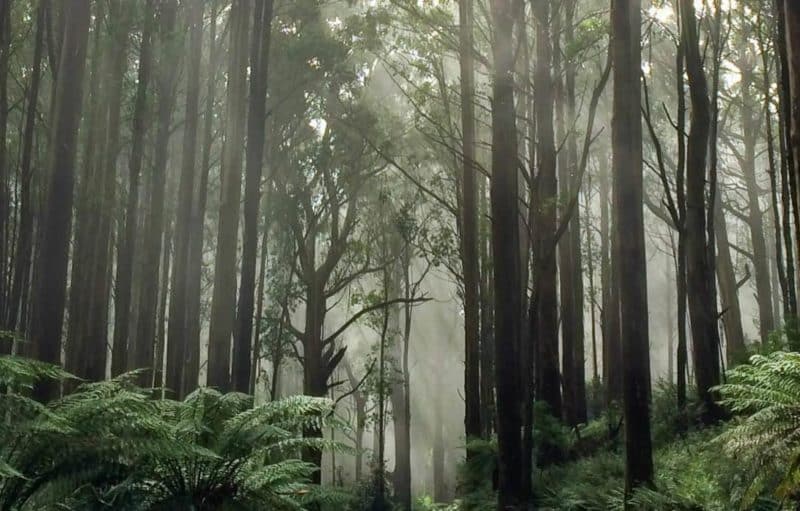PARK WATCH Article March 2023 |
Nature Conservation Campaigner, Blake Nisbet, on how we can protect the Mount Donna Buang Wingless Stonefly
The extraordinary Mount Donna Buang Wingless Stonefly (MDBWS) was deeply threatened by the Warburton Mountain Biking Destination proposal. This unique and critically endangered creature requires the use of our threatened species laws for its protection.
For many Victorians, Mount Donna Buang is a special day-trip destination, known for its panoramic views of Melbourne and the surrounding mountain ranges in the summer, and for snow-chasing and tobogganing in the winter. Just north of the Warburton township in the Yarra Ranges National Park and sitting at a comfortable 1,245 metres above sea level, this lush alpine mountain is the closest snowfield to Melbourne come winter, and hosts stunning patches of Mountain Ash Forest, Snow Gum Woodlands and Cool Temperate Rainforest, making it a great place to explore all year round. But, for one little creature, this mountain is not just for day tripping. For the MDBWS, this mountain is home.
MDBWS (Riekoperla darlingtoni) is an extraordinary creature. It’s one of only two stonefly species in Australia which are wingless, with a current area of occupancy known only to the mountain springs and high-elevation streams surrounding Mount Donna Buang. Remarkably, when these springs and streams dry out over summer, the MDBWS is able to burrow into the damp substrate where moisture is retained to survive the summer. The combined features of flightlessness, ability to survive cessation of stream-flow, and long life-span (three years) render the MDBWS of high scientific interest.
Unfortunately for the MDBWS, it finds itself on the pathway towards extinction, listed as ‘Critically Endangered’ under Victorian legislation and internationally under the International Union for Conservation of Nature (IUCN). There has been a delay with the federal listing of this species, but the MDBWS is currently being re-assessed under Commonwealth legislation.
Despite occurring entirely within a national park, the MDBWS is extremely sensitive to disturbance and is faced with significant and compounding threats, such as climate change, run-off and pollutants from car parks and visitor facilities. A more recent threat is a proposal to establish extensive mountain biking tracks throughout its known range. The highly specialised adaptations of the MDBWS, combined with its low dispersal abilities and extremely limited distribution, accentuate any threat to its habitat.
The first step is through a Critical Habitat Determination (CHD), a tool under Victorian legislation which gives a legal status of protection to a listed species’ or community’s critical habitat. Once determined, public authorities must give proper consideration to the CHD under Victorian legislation, which in turn would influence the conduct and behaviour of relevant public authorities and positively impact the treatment of threatened species and communities. A CHD also triggers a requirement from the minister to consider whether a Habitat Conservation Order (HCO) is required, a higher level of protection for critical habitats under the same Victorian legislation. An HCO trumps the planning scheme and gives the minister powers to suspend any licenses, authorities or approvals that contravene an HCO.
The Action Statement for MDBWS states that Mount Donna Buang and its surrounds constitutes a key part of the critical habitat for the MDBWS with reference to the Victorian legislation, but no formal CHD has been made for the species. In fact, there is no record of any CHDs ever being determined under Victorian legislation, meaning that this vital tool for biodiversity conservation has been completely neglected, and we are yet to see its full powers in play.
This is despite the provision under the Flora & Fauna Guarantee Act having been in place since 2019, which clearly states the circumstances under which a CHD is required. The lack of CHDs is likely linked to the department’s failure to release its long-promised guidelines for CHDs.
The need for a CHD (and HCO) in respect of the MDBWS is highlighted by the recent mountain biking proposal on Mt Donna Buang, which amongst other things, threatens the Wingless Stonefly through the risk of direct mortalities from bike tyres and the introduction of pathogens (such as Myrtle Wilt) which could decimate the small pockets of habitat this insect relies on.
We thought that threatened wildlife habitats would have been protected within national parks, but as we have seen with the Warburton Bike Track Proposal, not even park status can guarantee their safety. Elements of the revised bike track could still have negative impacts on the Stonefly, so an added level of protection is very-much required, to ensure the same fight doesn’t need to resurface again when the next ‘bright idea’ proposal gets put forward.
Did you like reading this article? You can read the latest full edition of Park Watch magazine online.
Want to be kept up to date about this and other nature issues in Victoria? Subscribe to our email updates.
You can also receive our print magazine Park Watch four times a year by becoming a member. Find out more.
